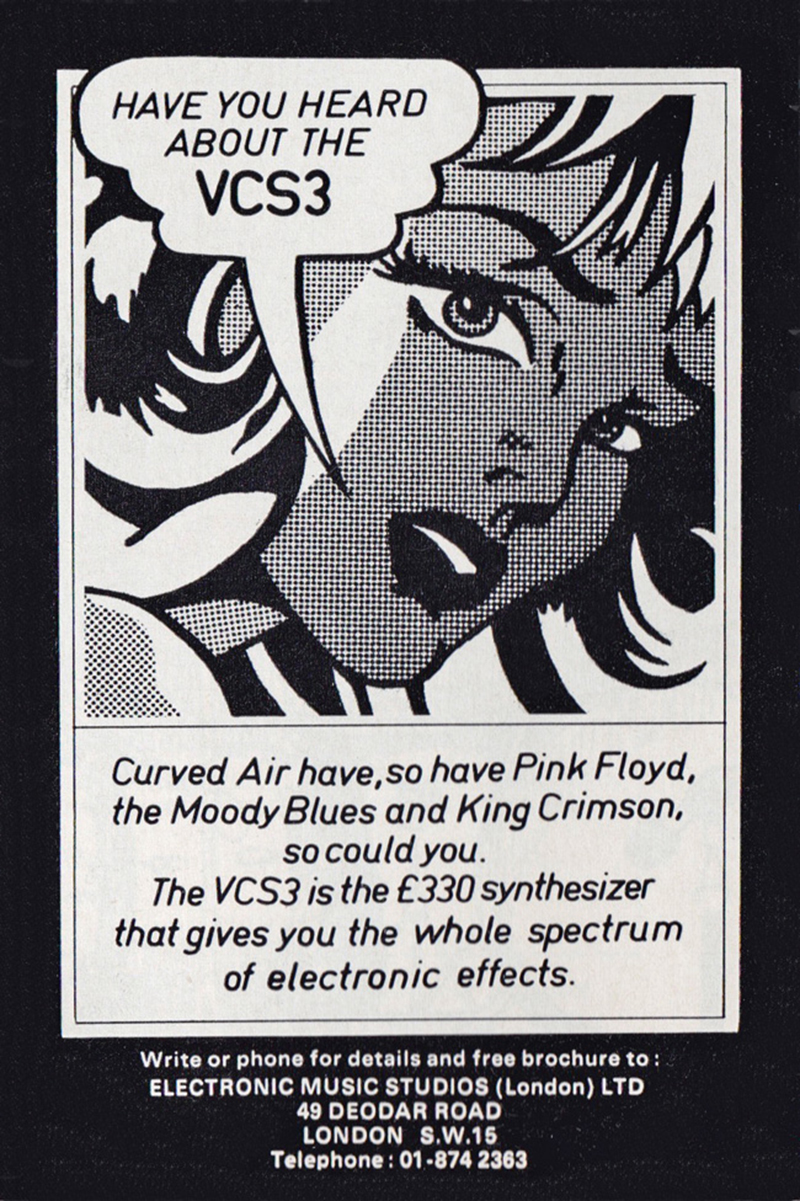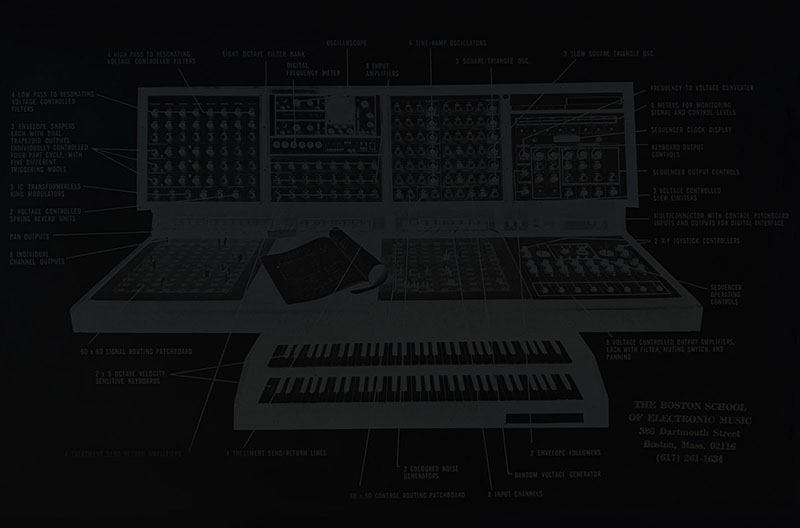
Think Of A Sound – Now Make It !
EMS, Peter Zinovieff and David Cockerell. PART 1 by James Gardner
In the minds of most Modulisme fans, the name of Peter Zinovieff is primarily associated with the range of synthesisers produced by EMS, the company he co-founded in 1969.
Yet Zinovieff, who died in June this year at the age of 88, would almost certainly have preferred to be remembered for the collaborative works he produced in the unusually productive last decade of his life, than for what he viewed as the “pathetic little synthesisers” that EMS produced. He was also particularly proud of the joint projects with Harrison Birtwistle and Hans Werner Henze that he realised in the 1970s in his computer music studio – the first in the UK.
I think it’s more constructive, however, to view these two strands – the “serious” computer music studio and the “commercial” synthesiser company – as complementary rather than opposed. At least in principle, both were predicated on the idea of allowing a great deal of freedom on the part of the synthesiser/studio operator, and during a time when the uses of the hardware, and the meanings of the sounds it produced were still being negotiated.
It’s important to stress just how active PZ was in his later years. From 2010 he collaborated on about a dozen pieces with artists including the violinist Aisha Orazbayeva, poet Katrina Porteous, cellist Lucy Railton, and his vocalist grand-daughter Anna Papadimitriou.
While he did produce a number of works on his own in the mid-late 60s, he’s probably best viewed as an animateur – whose forceful personality could spur people into action – or as a collaborator, entering into productive dialogues (and sparring!) with like-minded creative artists and unblinkered engineers.
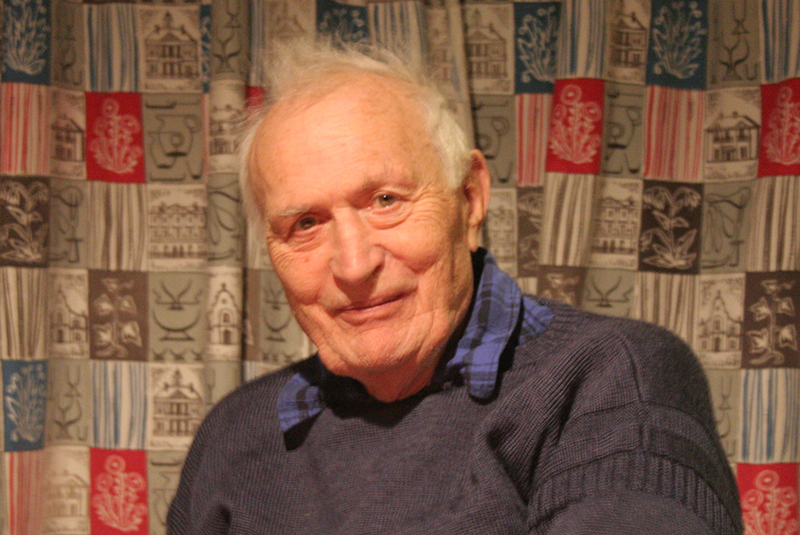
Photo: James Gardner
Peter Zinovieff and his studio
Peter Zinovieff set up an electronic music studio in his home in Ebury Street, London, during 1962. He had lessons in tape editing and basic tape manipulation techniques from Daphne Oram towards the end of 1962. Oram wrote to Hugh Davies in February 1963, saying that her pupil was “only just starting out in E.M.”, but had “quite a lot of equipment at his London home”.
I was working as a mathematician in the Air Ministry and earning not very much money. But in those days we were taxed very highly, because my wife had quite a lot of money, and so it was useless, you know, I just slaved away doing boring jobs on atomic physics. So I gave it up and decided to take up an old interest, really, which was experimental sound which I’d been involved with a tiny bit at Oxford. And then I found that I really didn’t even know how to cut up a tape. So somehow I found out about Daphne Oram and asked her to give me lessons, which she did. I went to several lessons and she gave me homework like making up a tune out of bits of spliced tape and things like that; speeding up and slowing down tape recorders.
Zinovieff quickly became frustrated with tape editing as a way of constructing pieces and his interests in producing sequences of pitches without recourse to razorblades and splicing tape led him to build a kind of sequencer that used Post Office uniselectors to choose pitches from a bank of oscillators.
The first thing I did was to try experimenting with uniselectors. These were the things that used to operate telephones in exchanges; when you dialled a nought it took quite a lot of time to send the pulses down: bu-bu-bu-bu-bu-bu-bu-buh, and then it was interpreted in the telephone exchange by these machines chugging round until at last the right number was selected.
That was electromechanical, so there was all the thing of whatever I did to dampen the clicks, you know, there were terrible clicks and a terrible amount of wiring. And so that wasn’t any good either.
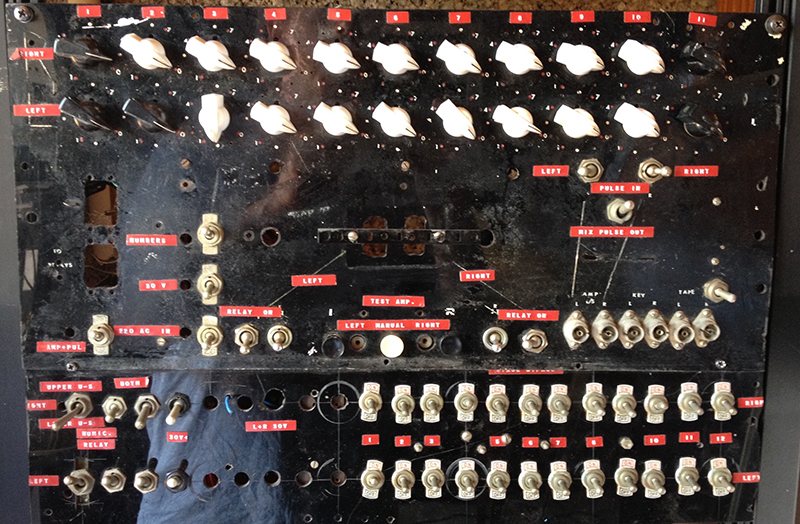
Photographed in June 2018 by James Gardner
A lot of that early equipment would have been bought from army surplus shops and things like that.
Yes—it was wonderful. In London there was a street called Lisle Street, and it was just a succession of one shop after another selling ex-Army, -Navy and -Air Force junk. Sometimes there were huge machines with thousands of tubes and valves and dials and they would do things like signal analysis and there were sound generators, noise generators, filters. This was all 19” rack-mounted stuff. They were very, very good; very high specs and things.
Towards the end of 1965, Zinovieff moved into a house at 49 Deodar Road, Putney and the studio equipment went into a purpose-built structure in his garden, which backed on to the River Thames. By this point he was getting more seriously involved in electronic music and he entered into a loose, short-lived creative and commercial partnership with Delia Derbyshire and Brian Hodgson from the BBC Radiophonic Workshop, under the group name Unit Delta Plus.
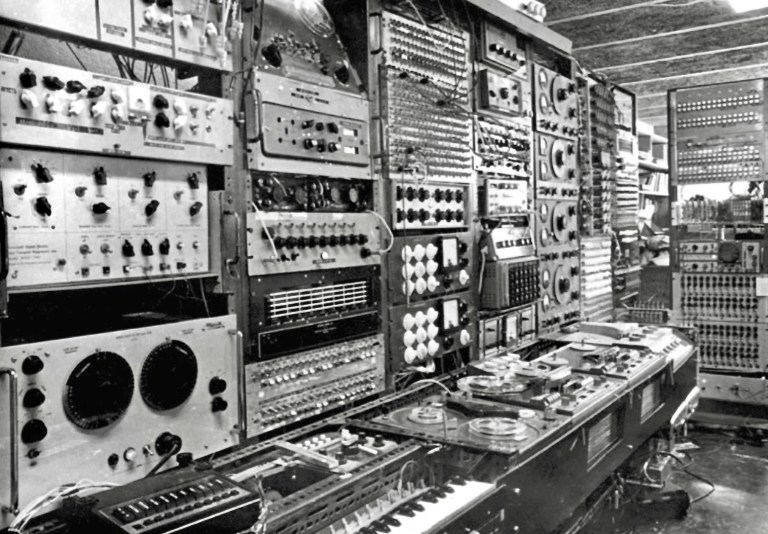
The device in the rack (with the oscilloscope in the middle) on the right of the photograph is the “stochastic tone generator” designed by Mark Dowson.
Zinovieff’s interests in controlled randomness, probability and sequencing led to the construction in early 1966 of a kind of ‘stochastic tone generator’, built mostly by Mark Dowson. This device allowed the independent setting of the pitch, volume, and duration of 32 different tones, or steps. The actual order in which the tones were played was usually random (courtesy of an old radium-dial wristwatch and a Geiger-Müller tube) but the probability of the occurrence of each tone was independently controllable.
This device was used for a number of the projects that Unit Delta Plus undertook during 1966. It was prominently mentioned in one of the programme booklets prepared for UDP’s concert at the Watermill Theatre in Bagnor, Newbury, on September 10 that year, apparently the first concert of all-electronic music in the UK.
Two of Zinovieff’s earliest pieces, Tarantella and Agnus Dei, were played at this concert, and each represents one of Zinovieff’s longstanding compositional preoccupations. Tarantella is a short study with a more-or-less constant pulse and a narrow timbral range; but the specific pitches heard at any given moment were determined by probability-weighted randomness, and the loudness set randomly between two limits.
Agnus Dei, on the other hand, reflects Zinovieff’s interest in concrète sounds, which he always found a much richer source of material than sounds generated from scratch electronically. In this case, the most audible element was tape- manipulated singing voice.
The Unit Delta Plus concert also included a Zinovieff/Derbyshire piece, Random Together I, which was specifically designed to be accompanied by light projection by the Hornsey College of Art. As well as heralding Zinovieff’s interest in collaborative composition, the piece made extensive use of “probabilistic methods” to determine various sonic parameters including reverb levels, the ordering of sounds and so on.
The ‘stochastic tone generator’ turned out to be an intermediate technology. The hundreds of controls that festooned its front panel proved unwieldy, and in any case, Zinovieff’s compositional ambitions soon exceeded its capabilities. He wanted to take the concept a step further, and wanted to define rules controlling the order in which notes occurred. Mark Dowson realised that what Zinovieff needed was a digital computer, and suggested he buy a PDP-8 – one of a new generation of relatively small, comparatively inexpensive machines.
So it was that in mid-1967, Zinovieff acquired a DEC PDP-8/S in order to act as a sort of ‘super-sequencer’, which superseded his earlier attempts at automated sound-control.

Once Mark Dowson had suggested a computer to you, it wasn’t then a question of nipping down to the shops to buy one.
No, well there was only one – the only sort which could possibly fit was a Digital Equipment [Corporation] PDP-8, which was a new generation of transistor process control computers. It had very little power – it had 4K of memory – and was very slow. And it cost a bomb. It cost £4000 in those days. And the extra 4K of memory which we got also cost £4000 so we made 8K of memory in total. Which is less than anything you can get now.
As mentioned earlier, Zinovieff’s wife Victoria had a substantial allowance from a family trust, which enabled him to focus full-time on electronic music and the studio, but even so, a lump sum of £4,000 was not immediately available to her. Bear in mind the average yearly salary was then around £730.
She did, however have a tiara…
We sold the tiara for £4000. It was a ridiculous thing, made of pearls and things, and it could come into brooches. And she wasn’t the sort of person who would wear it anyway. It was just sitting, waiting to be robbed in our house. So we sold that for £4000, and in fact that exactly matched the cost of a computer, so it was a really good bargain.
By the time Zinovieff’s PDP-8 arrived, however, Mark Dowson had left to work for the cybernetician Gordon Pask, but as his successor he recommended his childhood friend, David Cockerell, who had shared his early fascination with electronics.
Enter David Cockerell
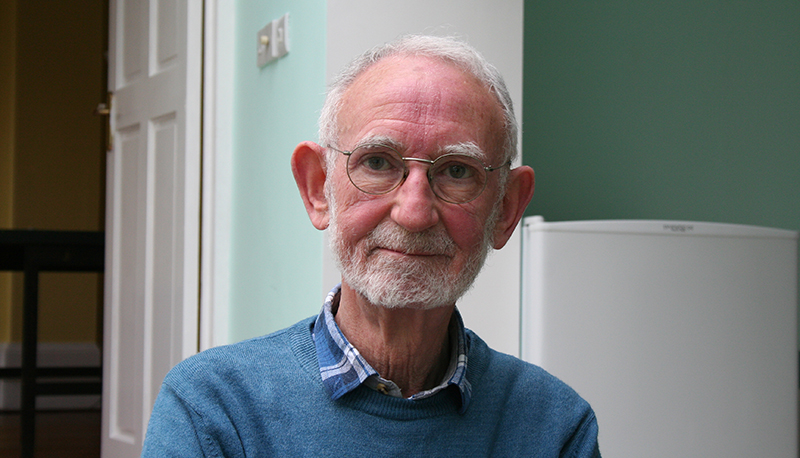
Photo: James Gardner
Cockerell had started out as a philosophy student at Keele University but switched to study electronic engineering at Regent Street Polytechnic (now the University of Westminster). By the time Cockerell started working part-time for Zinovieff, around September 1966, he’d already made rudimentary reverb/delay machines using tape loops, and a ring modulator. More significantly, though, he’d made a “music box” for fun. This device packed a lot of features into a compact design: an oscillator controlled by an eight-note transposable sequencer with a ‘tempo gate’, which modulated the timing between successive notes; random control of the number and order of sequence steps; three bandpass filters; a decay control; vibrato oscillator; spring reverb, and more. As far as I am aware, no one in the UK had built anything quite like this at the time.
The original unit was apparently displayed at the Cybernetic Serendipity exhibition (about which more later) then shipped to San Francisco and lost. Two copies of this device were later made, however. One was given to Zinovieff and the fate of the other is unknown. The former unit came to light again in 2018 and – refurbished – is now in a private collection in Australia.
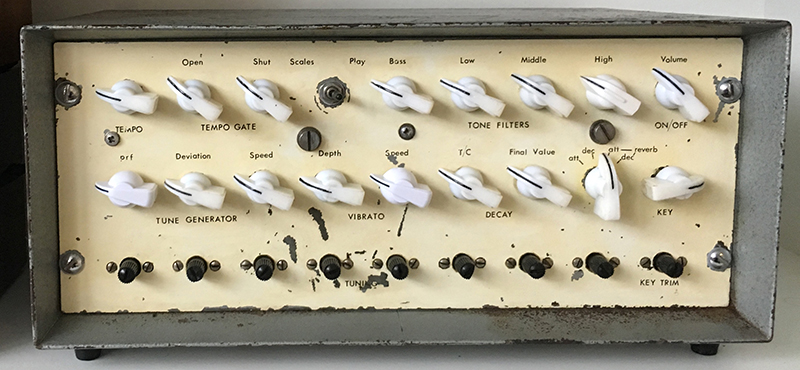
Photo: supplied by the owner, and used with permission.
Zinovieff:
So David came on the scene and…I mean he was – and I suppose still is, really – a sort of breath of fresh air to electronic music.
Why do you say that?
Well because he’s got that genius of… you could say to him ‘I wonder how I could have this – could you make me this?’ And he’d look at you blankly for about 10 seconds, 15 seconds, and then he would just say ‘yes’. And then you’d wait a week or two and he’d make it. He’d put together whatever I wanted.
David Cockerell, what were the first things you built for Peter that took him closer to his goal?
Voltage-controlled oscillators. On most oscillators before then you’d had to turn a knob to change the pitch but Peter found some rather good American ones [Wavetek] where the pitch could be changed by a voltage, which meant the pitch changes could be automated.
And from there you went on to build banks of equipment in Zinovieff’s Putney Studio.
Yes, I soon left my job with the National Health Service and went to work full-time for him making the equipment for his studio. I’d been spending a lot of time fiddling around making – for my own amusement – a sort of synthesizer and a sequencer, [see above] having read a very early article by Bob Moog in a popular magazine.
What did you learn from Moog’s article?
He had the idea of exponential voltage control, which was to control oscillators and filters and all the sound-generating stuff from voltages so that you could patch them all together and make something that made a really complex sound.
But at the Putney studio we soon got past voltage control and got into this computer control of everything.
Peter, from that point on did the computer really change the way you worked, and did it do the sort of things you were expecting it to do?
Yeah, completely changed, because once you had something that could control equipment, then you could build rather elaborate equipment […] And it could be controlled directly by the computer. So the computer didn’t – like modern computers do – have to do very much. It didn’t actually have to produce sound, and it didn’t have to work out very much, or the things that it had to work out, it could do beforehand. And then all it had to do was to send signals in succession to different bits of equipment. And so if it could do that several thousand times a second, that was rather like cutting a thousand slices a second of a tape, say.
Among the first pieces realised at Putney using the computer-controlled studio were March Probabilistic and ZASP, programmed during 1967. These were actually created in collaboration with Alan Sutcliffe, then working at ICT (International Computers and Tabulators), just across the river from Zinovieff’s house. Sutcliffe programmed the pieces on an an ICT 1905 mainframe, and the paper tapes produced were then taken over Putney bridge and loaded into Zinovieff’s PDP 8/S, which controlled Cockerell’s sound-producing devices.
ZASP won the second prize at the 1968 IFIP (International Federation for Information Processing) Computer Music Competition, losing out to Xenakis’s ST/4-1, 080262.
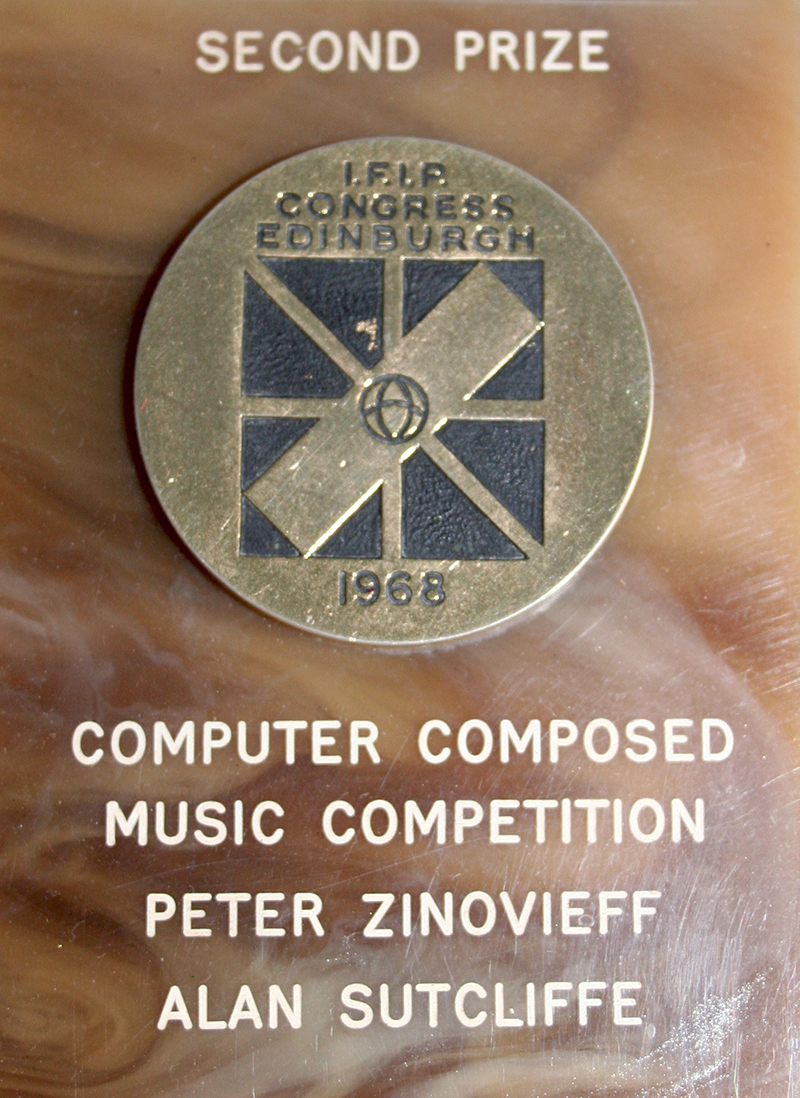
Photo: James Gardner
But as far as Zinovieff’s work was concerned, the event that made the biggest impact that year was the concert he and Tristram Cary programmed at the Queen Elizabeth Hall on January 15.
Billed as the ‘First London Concert of Electronic Music by British Composers’, it included works by Delia Derbyshire, Ernest Berk, Tristram Cary, Daphne Oram, George Newson, Jacob Meyerowitz and four by Zinovieff himself – one a collaboration with Alan Sutcliffe. Ian Helliwell’s ‘Tone Generation’ feature on this programme may be heard here:
https://www.mixcloud.com/ianhelliwell/tone-generation-programme-25/
The concert attracted much advance newspaper publicity, drew a capacity audience, and mixed reviews. The concert, and Zinovieff’s studio, featured in an episode of BBC1’s popular technology TV show, Tomorrow’s World, which aired on 6 March. It can be seen here:
https://www.bbc.co.uk/archive/peter-zinovieff–early-electronic-music/zmyf7nb
Unsurprisingly much of the media coverage focused on Zinovieff’s own Partita for Unattended Computer. For this piece, just one rack of Zinovieff’s studio equipment, which included the PDP-8/S, Cockerell’s interface, and oscillators, was transported to the QEH along with a teletype and paper tape reader, and placed on stage for the performance. As the programme booklet explained:
A small computer towards the centre of the rack works the teletype paper tape reader so that a programme is fed into the memory of the the computer. On the basis of this programme, the computer then calculates the exact details of what sounds are to be produced and how best to operate the rest of the machinery in order to realise them. A large amount of freedom has been given to the computer so that it is in reality a live performance. More than this; there has been no actual rehearsal of this piece for the simple reason that each realisation will be essentially different.”
Zinovieff’s computer travelled twice more in 1968, first to the Connaught Rooms in London to perform pieces by David Lumsdaine and Justin Connolly at an SPNM Composers Weekend in July, and the following month to the ICA for the famous Cybernetic Serendipity exhibition. At Zinovieff’s behest, Cockerell came up with a crowdpleasing “whistle interface” that allowed visitors to whistle or sing a tune into a microphone – the computer would then generate and play back a set of variations on the theme provided. According to Mark Dowson, “at the official exhibition opening, Princess Margaret whistled the British National Anthem.
More significantly, Cockerell recalls that while setting up the studio for this exhibition, Zinovieff told him of his intention to establish a company to sell products.
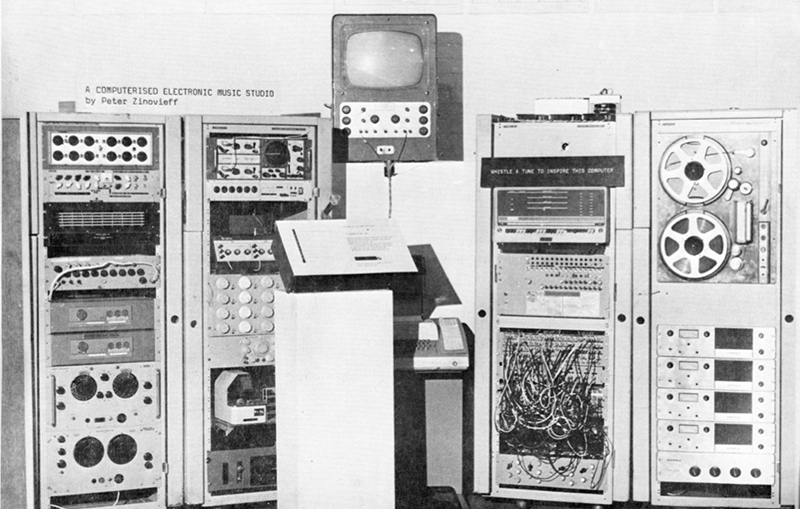
Photo: Humphrey Evans, reproduced in the programme booklet of the Queen Elizabeth Hall concert, 10 February 1969. From the author’s collection.
Ian Helliwell’s ‘Tone Generation’ programme about the Cybernetic Serendipity exhibition may be heard here:
https://www.mixcloud.com/ianhelliwell/tone-generation-programme-33/
Tristram Cary, EMS, and the VCS3
It’s not entirely clear when Tristram Cary was initially contacted by Peter Zinovieff (accounts differ) but it appears to have been in late 1966, when Cary was working on his own electronic music for Expo 67. Apparently Zinovieff invited Cary to be a part of Unit Delta Plus, but being “not much of a joiner”, declined. He nevertheless visited the Deodar Road studio and met Zinovieff and Cockerell.
In this three-person team, Cary functioned as something of a middleman between – or as a counterbalance to – Zinovieff and Cockerell. Cary had considerable skills in conventional instrumental composition, and had provided electronic music and sound effects for films and television, including Doctor Who. He’d been working with manipulating sound on disc since the late 1940s and had built his own electronic music studio in Fressingfield, Norfolk, and he was an early example of someone who combined the roles of ‘musician’ and ‘technician’
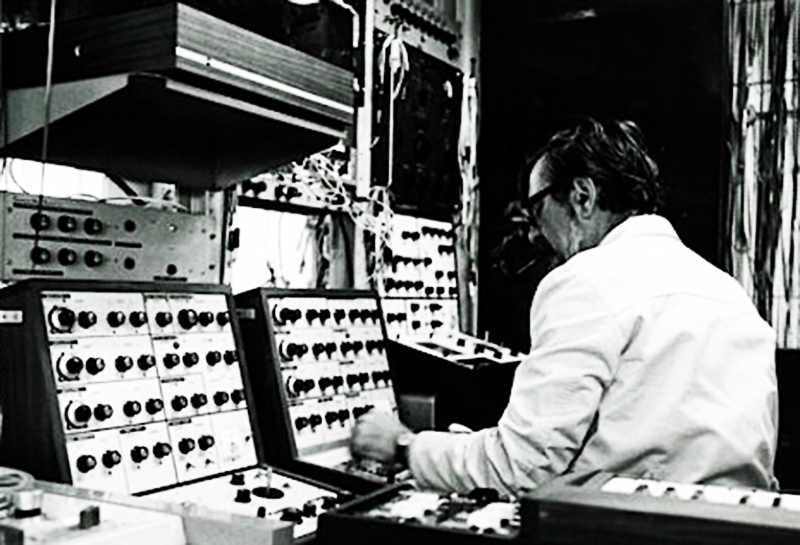
By mid-1968, Zinovieff’s Putney studio was gaining recognition. But it was expensive to maintain and expand, and despite Zinovieff’s access to considerable wealth an additional source of revenue was necessary. Indeed, according to Brian Hodgson, the need for money had been one of the motivations for setting up Unit Delta Plus a few years earlier:
Peter wanted to do his research, and Delia and I were doing the odd commercial, and theatre stuff. And we hoped to create enough money at that to pay for the running costs of the studio
Cockerell recalls a conversation with Zinovieff in July 1968 about establishing some kind of company to sell electronic music hardware; at the time, the two were setting up a section of the Putney studio at the ICA for the aforementioned Cybernetic Serendipity exhibition . The following month The Guardian published an article by Cary in which he argued for a National Centre for Electronic Music, which included this intriguing paragraph:
Two manufacturers in America, Moog of New York and Buchla of San Francisco, do market electronic music devices in modular form[.] […] But the prices are high even by US standards […] and allowing for the devalued pound and other burdens on the importer they are quite out of the question for most British customers. In any case we have our own brilliant designers who would produce better and cheaper systems if they turned their attention to it
By ‘our own brilliant designers’, he surely meant David Cockerell, and the task of producing ‘better and cheaper systems’ was one to which the team was already turning its attention. It seems likely that sooner or later they would have produced some kind of commercially available electronic music equipment; partly to fill the obvious gap in the market that Cary had identified, and partly to finance the Putney studio.
But in the Autumn 1968, a catalyst arrived to accelerate the process: Australian composer Don Banks. He’d been in the UK since 1950, and like Tristram Cary was a pragmtic jobbing composer who did much film and TV work, as well as what Cary would call ‘concert music’ – the two composers’ paths had already crossed thanks to their movie assignments. Banks’s interest in electronic music had been piqued by a 1966 Paris performance of Mario Davidovsky’s Synchronism 2 for four live performers and pre-recorded sounds, but he had neither studio access nor enough money to purchase any suitable electronic equipment of his own.
When spending an evening with Peter Zinovieff I complained bitterly about the lack of facilities for composers to learn the language of electronic music. Peter, as generous as ever, said he would ask David to design a kind of instrument which would incorporate a number of facilities which one would need to know about in the production and treatment of sound. 3 weeks later I had a grey box […] which incorporated all the basic principles. At the time it was known as the ‘Don Banks Music Box.’
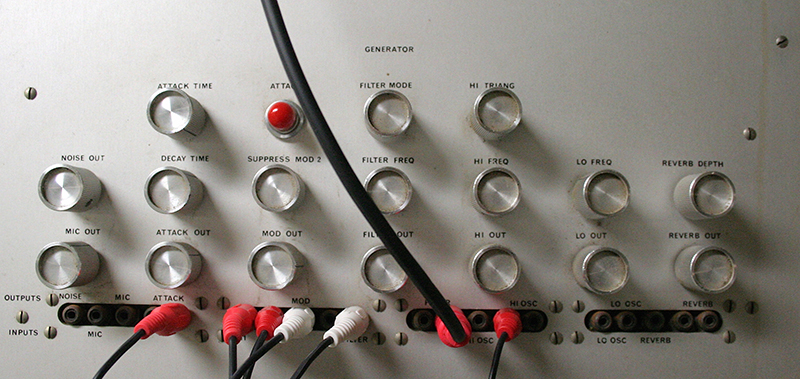
Photo: James Gardner
Banks’s price limit for the DBMB has been variously reported as £50 and £100, but either way this meant that the functions that Cockerell included in his design were restricted to what he, Cary and Zinovieff felt were essential. In the end the spec was this:
1. White Noise Generator.
2. Microphone pre-amp.
3. Envelope Generator (with attack and decay controls only).
4. High Frequency Oscillator (sawtooth/ triangle with variable waveshape) with a quoted basic frequency range of 1Hz to 2kHz, but greater via voltage-control.
5. Low Frequency Oscillator: falling sawtooth wave only, with a quoted range of 0.25–300Hz.
6. Filter with variable Q, capable of self-oscillation.
7. Ring Modulator/Voltage Controlled Amplifier.
8. Spring Reverb.
It’s worth noting that the DBMB doesn’t offer an easy way of producing sequences of specific discrete pitches from its front panel controls, or straightforward control of pitch from an external keyboard. In other words it’s not designed to play tunes – hardly surprising, given Banks’s requirements and Cary and Zinovieff’s aims. The patching, by means of RCA connectors, is reasonably flexible, allowing devices to be connected in many different ways; there is no normalised signal- or control path. The DBMB is a compact, self-contained device designed for sound-generation and -processing, and offering a fair amount of ‘bang for the buck’. Although the DMBM was later referred to as the ‘VCS-1’, it would be misleading to see the DBMB as a VCS3 ‘prototype’: there seems to be no evidence, at the design stage, of a vision of a more sophisticated commercial synthesiser for which the DBMB was a portent.
Banks himself didn’t see his synthesiser as the VCS3’s linear forebear. Asked in 1977 whether the DBMB was ‘the beginning of the VCS3’, he answered:
Well, yes, in a very funny way I expect it could be seen as that. But it was only because I was putting the pressure on Zinovieff that…you know, there were a whole number of independent composers who needed help, who needed to be able to work at home. And I expect probably from that [the VCS3] did start. But that was not originally…not in Zinovieff’s mind. I think it just happened that he saw there was a demand.
Just three DBMBs were built. The other two units eventually went to Lawrence Casserley – then Cary’s student at the Royal College of Music – and to Banks’s friend, the Australian composer Keith Humble. Humble’s DBMB was later built into a larger unit (along with an EMS twin ring modulator) by engineer Graham Thirkell and is now in the collection of MESS Ltd, Melbourne.
The DBMB, while useful, was not, in Cary’s opinion, sufficiently well-specified to be a viable commercial product, but “it spurred us on to dream up a more sophisticated package with features we couldn’t put into Don’s little grey box” . Asked whether Banks had helped in the VCS3’s development, he replied:
yes, in the sense that his request for a machine made the three of us put our heads seriously together to decide what would be a useable and saleable package to put into a production model”, a package that “would appeal not only to composers but also to schools and people like that. A very good teaching instrument for acoustics and so forth.
The EMS Electronic Music Studio Mk I
Following their success with the January 1968 concert of electronic music at the Queen Elizabeth Hall, Zinovieff and Cary organized a second in February 1969. It included work by Harrison Birtwistle, Zinovieff and Justin Connolly, Alan Sutcliffe, Don Banks, Cary, Donald Henshilwood, Hugh Davies, Lawrence Casserley, and Ernest Berk.
The concert’s elaborate foil-fronted programme booklet includes many essays and interviews, as well as about 20 pages of ‘advertorial’ for EMS.
The team seems to have flirted briefly with the name ‘British Electronic Music’ at the end of 1968, but the name ‘Electronic Music Studios’ appears here for the first time. Although EMS would not be incorporated as a Limited Company until July 1969, EMS presented itself in the brochure as a going concern offering no less than three products, which are described in some detail. The first two – the Twin Ring Modulator, and the Dynamic Filter were made, albeit in very small quantities. But it’s the third product that’s of most interest for the VCS3 story. This is the ‘EMS Electronic Studio Mark I’, with a quoted price of £260. Its specifications suggest a rather more sophisticated unit than the DBMB.
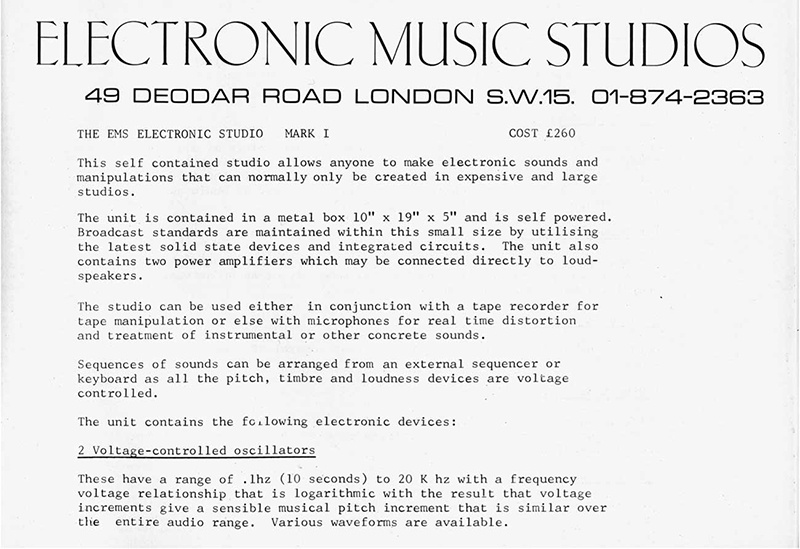
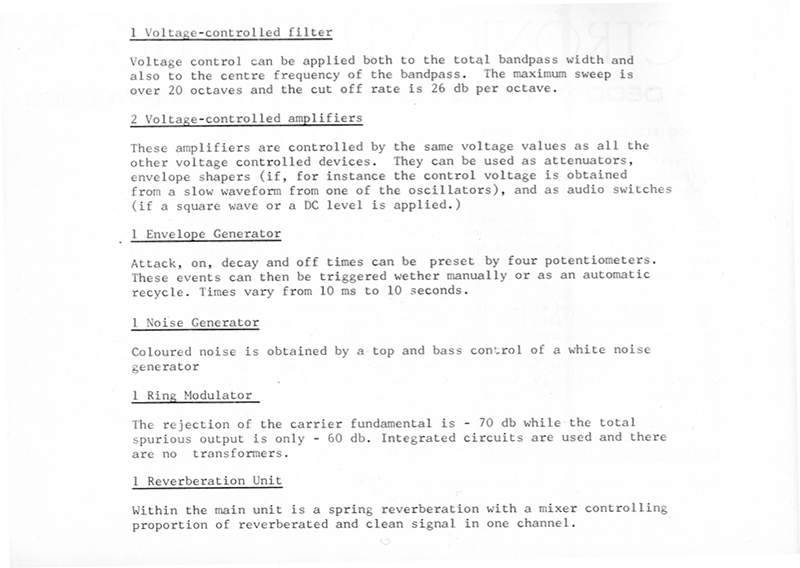
As the notional precursor to the VCS3, there are a few notable things about the Studio Mk I’s advertised features. It has two oscillators, which both have the same (wide) frequency range and provide ‘various waveforms’. There is a VCF with voltage-controlled centre frequency and, unusually, voltage-controlled bandwidth – just like EMS’s contemporary Dynamic Filter. The description of the envelope generator is very similar to that of the VCS3 (attack, on, decay, off, with optional automatic retriggering), and thus a significant advance on the DBMB, while the noise, ring modulator and reverb are similar to those of the earlier device. The instrument would appear, like the VCS3, to be designed as a ‘stereo’ (more accurately, two-channel) device – the DBMB was mono.
More significant, perhaps, is the first mention of the ‘Pin Panel Matrix’ for patching, This would be one of the VCS3’s most characteristic features and selling points – its purported advantages over patchcord interconnections included tidiness (by doing away with the “knitting” of wires) and a much more compact panel design (by dispensing with jack sockets).

Have any examples of the EMS Electronic Studio Mk I – the ‘VCS2’ survived? As so often with early descriptions of EMS devices, this enticingly detailed text is best described as somewhat ‘aspirational’. In later life, Cary seemed unsure about the putative device. In one account he says “I’m not sure what the VCS2 was like, or even if there was one” and in another. “The VCS 2 was abortive and intermediate”. David Cockerell has, however, confirmed that no functioning device matching the description of the Studio Mk I was ever actually built. Apart from anything else, he contends, its features as specified would not have fitted in a box of the quoted dimensions of 19” x 5”x 10”. It seems clear, then, that if anything can be called the ‘VCS2’ – the ‘missing link’ between the DBMB and the VCS3 – this piece of vapourware is it.
Tristram Cary’s VCS3 Prototype
Although the Studio Mk I was not actually made, its specification shows the direction Cary, Cockerell and Zinovieff were taking as they worked to design a viable commercial product during the early months of 1969. According to Cary, at least some of the discussions took place at the Cedar Tree Pub in Putney Bridge Road and it was reputedly there that the distinctive L-shaped ‘baby desk’ form of the VCS3 emerged, almost certainly from Cary’s wish that the two control panels could face the user – particularly useful in a teaching environment.
Cary hand-built the wooden case in this form for the prototype, which was delivered to Cockerell in Spring 1969. Contemporary documents suggest it was also Cary who devised the initial layout of the controls. Cockerell and Zinovieff both contributed to the specifications, and according to Cockerell, Cary insisted on the inclusion of a ring modulator. Cockerell was responsible for the circuit design and construction of the electronics, cramming on to two Veroboards in the prototype the components that would occupy three circuit boards on all subsequent VCS3s.
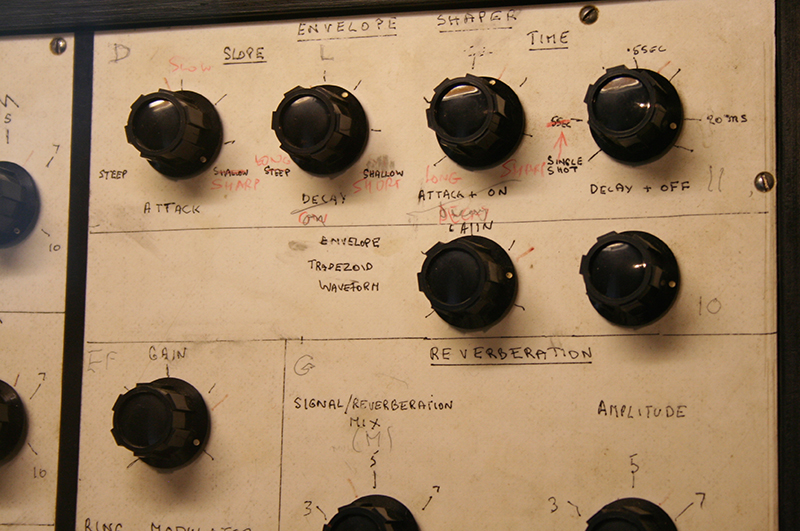
Photo: James Gardner
In the interests of keeping the costs of the VCS3 as low as possible, Cockerell’s circuit designs were simple and expedient, and largely based on public domain circuits. For the filter he adapted Bob Moog’s ‘transistor ladder’ design using diodes instead of transistors – diodes were much cheaper. The slow-motion Vernier oscillator frequency dials and matrix patch board were initially sourced from the electronic surplus shops in Lisle Street and it was also Cockerell’s idea to include a joystick in order to control two parameters at once.
Yet the specifics of Cockerell’s oscillator design decisions were also informed by the musical aesthetics of Cary and Zinovieff. Neither composer was overly concerned in their electronic music with stable, equal-tempered pitches. Despite the first brochure’s bold claim of ‘drift-free performance’, Cockerell’s initial oscillator designs did not prioritise frequency stability – much to the chagrin of later melodically orientated owners.
The production VCS3 incorporated the following devices:
1. Three oscillators, two designed primarily to operate in the audio frequency range and a third intended as a sub-audio control (though all three had a wide frequency range), all offering continuously-variable waveforms.
2. A noise generator with integral filtering for different colours of noise.
3. A filter with voltage-controlled cutoff frequency, capable of self-oscillation.
4. An envelope/trapezoid generator with attack, on, decay and off controls, with voltage-controlled decay.
5. A ring modulator.
6. A spring reverb unit, with voltage-controlled wet/dry mix.
7. Two input amplifiers/channels for processing external signals.
8. Two output channels.
9. Two built-in loudspeakers
The VCS3 also had a push-button for triggering the envelope generator, a joystick, and a meter for displaying signal or control voltages.

Photo: James Gardner
For Cockerell, though, this design represented something of a backward step from the “more interesting and intricate machines” he’d already been making for Zinovieff’s studio.
The rough-and-ready layout of Cary’s prototype was soon neatened, and its design formalized, into a one-off pre-production unit – pictured on the cover of the first VCS3 brochure, dated November 1969.
The ‘productionisation’ process of the synthesiser was, however, already under way by July 1969, and this was undertaken by the brothers Gerry and Brian Rodgers – soon to operate as EMS (Bournemouth) – who would work from a succession of small factories in Dorset.
Launched in November 1969, the very earliest VCS3s seem to have been sold at £285. Within weeks, however, £330 was established as the first settled price. While this represented a substantial outlay – over ten times the average weekly wage – the VCS3 still cost less than one fifth of a similarly-featured Moog. Their least expensive off-the-shelf model at the time, the Moog Ic, was $4305 – then around £1800. For a short time at least, the VCS3 had no real competition in the UK and in continental Europe.
Cary seems to have been aware at the time that EMS’s window of advantage would not stay open for long. In an interview in January 1970, he hoped that the VCS3 could “be developed, patented and sold to the American market before the Japanese catch up” While the evidence is slim, it would appear that the pressure to take advantage of this short-lived business opportunity was another factor in getting the VCS3 into production within a few months of its design.
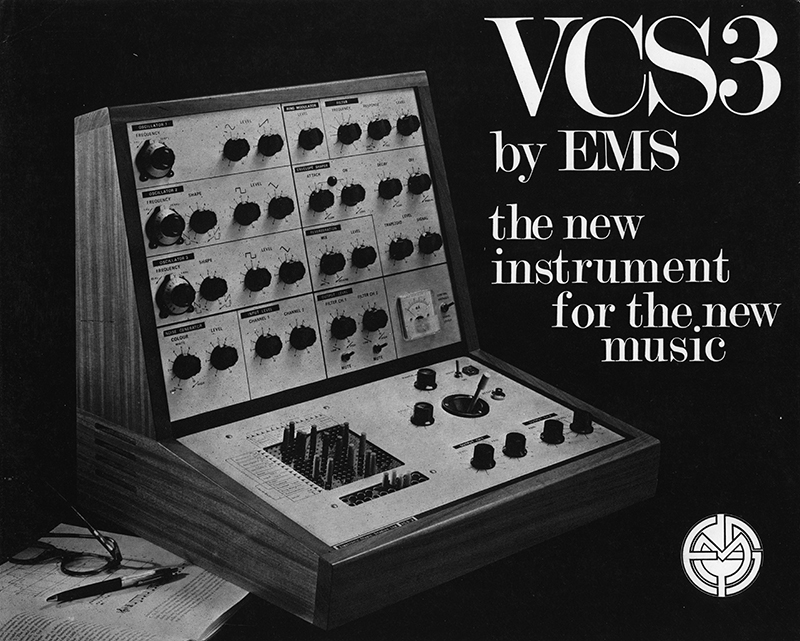
EMS archives, courtesy of Robin Wood.
The keyboard problem
EMS’s first American agent, Alfred Mayer, argued for the production of a conventional keyboard for the VCS3 when he took on the US distribution as Ionic Industries, Inc. in very early 1970. But it took EMS some months to get a unit designed, manufactured and on the market. Mayer was also responsible for insisting on “The Putney” as the alternative name for the VCS3 and, later, for naming the DK-1 keyboard “The Cricklewood.” The received wisdom was that Americans preferred names, and the British numbers, for products. One can only assume that those place names sounded more exotic to Mayer’s ears than they did to those of Londoners.
According to Cary, it was also Mayer who encouraged the change from DIN connectors – which appeared on early VCS3s – to the more widely-used quarter-inch jacks for external inputs and outputs, and the eight-way Cinch-Jones socket for the keyboard.
Because EMS didn’t release a keyboard for the VCS3 until about June 1970, it’s often been assumed that keyboard control was a grudging concession to commercial pressure, and not part of the initial design – typified by Cary’s celebrated quip “If they want to play a keyboard, they can buy a bloody piano”. Indeed, Cockerell himself has contributed to this confusion. When I interviewed him in 2010 he said:
Peter and Tristram weren’t really that much interested in well-tempered music. And I thought it should have had a keyboard from the start. We added one on as an afterthought.
Much can be made of – and read into – the VCS3’s lack of keyboard, particularly to highlight Cary and Zinovieff’s disdain, but it is worth remembering that none of the few commercially-available synthesisers at the time had integrated keyboards. The EML ElectroComp 200, made specifically for educational use, had none. Buchla, meanwhile, offered a ‘touch-controlled voltage source’ instead of a conventional keyboard. Moog did, of course, sell a conventional keyboard, but it was still a separate unit. The standard keyboard became an integral part of the synthesiser only with the advent of the Minimoog in October 1970.
In the case of EMS and the keyboard, the truth is more complicated, however. The final sentence on the first leaflet reads: “EMS will shortly announce a range of peripheral equipment including a sequencer keyboard which it will be possible to add to an existing VCS 3 by simply plugging it in, a special socket having been provided for this purpose”.
This would indicate that some kind of keyboard was in fact considered from the outset (albeit as an optional peripheral) and an examination of even the pre-production unit confirms this – it has an explicitly-labelled ‘keyboard’ socket on the back.
In fact, Cary and Cockerell did communicate about a keyboard designed specifically for the VCS3 as early as August 1969 – some three months before the instrument’s official launch – during the time the Rodgers brothers were readying the synthesiser for production. Cary’s proposal was for a decidedly unconventional device, however. In a memo to Cockerell and Zinovieff, he says: “I am in favour of deliberately not making the keyboard behave like a standard keyboard […] basically one wants two kinds of function – (1) voltages, (2) circuit makes and breaks i.e. switching. I suggest using the white keys for voltages and the black keys (20 in four octaves) for switching”. Space doesn’t allow me to go into great detail here, but among other things, Cary describes five split modes which allocated different output voltages to different groupings of octaves, and scaling controls that would allow micro-and macrotonal pitch steps, graduated filter control, and so on. He also proposed that the black keys could not only be used to make or break patch connections (via special leads to the patch matrix) but also operate other equipment, e.g. turning on and off tape recorders.
I’ve found no evidence that such an elaborate controller was actually made, but Cockerell did build a more conventional four-octave keyboard prototype – explicity labelled ‘VCS3 keyboard’ in his notes – around the same time. While much simpler than Cary’s speculative design, this device did allow the keyboard to be split in three different ways: all four octaves sending to channel 1; the upper two to channel 1 and the lower two to channel 2, or the upper three to channel 1 and the lowest one to channel 2. Both channels had independent “tuning” and “spread” controls, and there was also an attack mode switch that effectively determined whether the VCS3’s envelope shaper was triggered or gated from the keyboard. This keyboard went to Goldsmiths’ College in London where it was used by Don Banks, and is now apparently in the collection of the Kunstmuseum den Haag.
When it finally did appear, in mid-1970, EMS’s first actual production keyboard – The Cricklewood/DK-1 – retained the scalability of the experimental model, allowing the voltage range of the keyboard to be varied to produce micro- and macrotonal intervals. It also included a built-in sawtooth oscillator – the pitch of which was proportional to keyboard position – that could be used as an additional audio source for the VCS3. Unusually for the time, the keyboard was also velocity-sensitive (hence DK for ‘Dynamic Keyboard’), producing a voltage that was proportional to strike rate. This voltage would normally control dynamics (and was wired to do so with the built-in oscillator) but it could, of course, be assigned to any voltage-controllable parameter. According to Cockerell, “Peter persuaded me of the importance of velocity sensing”, and much time was spent designing a workable velocity-sensitive mechanism.
Curiously, the Synthi Users Manual, from 1971, describes a four-octave ‘Synthi Keyboard’, which could be operated in conventional manner, or could be split so the lower two octaves provided only a velocity-controlled voltage, on one channel, and the upper two octaves only a keyboard voltage on the other channel. I’ve seen no evidence such a keyboard was built, however, and it seems likely that this was the last gasp of Cary’s split-keyboard controller idea as far as EMS was concerned.
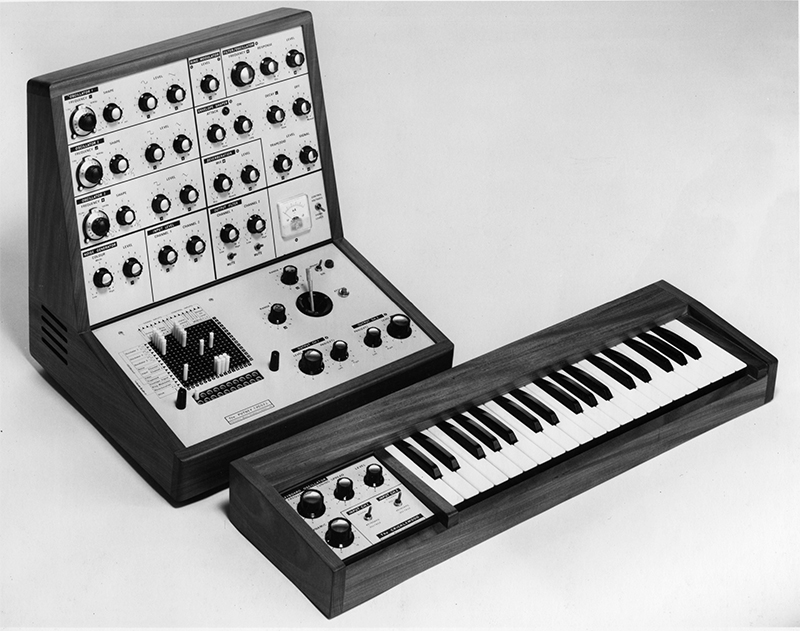
EMS archives, courtesy of Robin Wood
Belgrade calling
The Cricklewood/DK-1 keyboard was the only new product released by EMS in 1970, but Zinovieff, Cockerell and Cary were far from idle. Apart from spending a great deal of his time building and troubleshooting hardware for Zinovieff’s computer studio, Cockerell was working on a large new voltage-controlled system for Radio Belgrade’s electronic music studio, and in particular its most novel feature: a digital sequencer.
This project had been initiated well before the VCS3 was officially launched.
Paul Pignon from Radio Belgrade – who had already visited the Putney studio – wrote to Zinovieff in September 1969 with a view to EMS making a studio based on a voltage-controlled system. Probably at Cockerell’s insistence, Zinovieff suggested in his reply that “We might even be able to include some tiny computer or processor which would act as a very elaborate sequencer”.
According to Cockerell, he had already been looking into the feasibilty of using the newly available memory chips for sequencing at the time, which was hardly surprising given the importance of sequential control in the Putney studio. He recalls demonstrating “a breadboard with about a dozen such chips” to Zinovieff in December 1969 as part of the development for the Belgrade synthesiser, which might explain EMS’s rather optimistic claim on the first VCS3 brochure that they would “shortly announce a range of peripheral equipment including a sequencer keyboard”.
In fact, progress on the digital sequencer would be agonisingly slow, and there was also at first a question about how seriously Zinovieff was taking the Belgrade project. As Cockerell recalls, “They’d asked us to make something and we didn’t really want to do it, so Peter told me to do it the easiest way I could, even if it was expensive, and then they said ‘yes’. Then we had to get down to work and make something that we’d be proud to sell.”
The fascinating development of the machine’s specification is chronicled in the correspondence between EMS, and Pignon and his Belgrade colleagues, during 1970. Space doesn’t permit a detailed description, but the synthesiser proposed grew from being essentially an expanded VCS3, to something much more complex and elaborate. By April, the spec. included six VCOs, two joysticks, a 40 x 40 patch matrix, and a “six-way stereophonic mixer”, but it was clear that the sequencer design was not proving easy. At this time a 1188-bit memory was described, allowing a maximum sequence length of just 66 18-bit words.
Not surprisingly, the Belgrade team was not impressed by this, nor by the proposed allocation of just five bits per event for pitch – allowing only 32 discrete pitch levels – or the suggestion that a three-octave keyboard would suffice. They suggested seven bits for pitch and the provision of two three-octave keyboards that could be connected to give six octaves – the final machine would use six bits for pitch and two 64-note dynamic keyboards.
In mid-1970, however, there would be an important and catalytic intervention in the synthesiser’s design – the BBC Radiophonic Workshop.
As Brian Hodgson recounted to me:
At the Workshop we’d started using the VCS3. So when we heard that Radio Belgrade were going to get Peter to put three VCS3s together and do a control system, and that it would have a [66]-way sequencer – at that point they decided to completely redesign the whole thing as a ‘Belgrade’ – we saw this as a viable alternative to the Moog [which the Workshop had planned to purchase]. And Delia and I created quite a ruckus and persuaded Desmond [Briscoe] to get one. He was trying to push the BBC for a Moog and we told him that we felt he should go for the EMS synthesiser, and that as it was British we would have more control over its development. It took some persuasion as he had set his heart on the Moog but eventually he agreed.
So you and Delia were the drivers
Yeah. Of the acquisition of the Delaware. We didn’t want to call it ‘Belgrade’ because it didn’t make any sense to us. And I remember somebody said to us ‘you should call it The Delia’. I don’t think Delia was that keen. The Radiophonic Workshop was in Delaware Road, Maida Vale and so that was why it was called the Delaware.
Who came up with the name?
I think I did. I was good at names.
By the end of July 1970, EMS had quoted the BBC a price of £5400 for The Delaware, whose specification was by now essentially the same as Belgrade’s synth and indeed pretty close to the sort-of-standardised production model, the Synthi 100, which would appear in 1971. But we’re getting ahead of ourselves.
Meanwhile, in August 1970, Cockerell was only now “about to test physically” the prototype sequencer, which could apparently handle just 128 events (3848 bits organised into 30-bit words). Designing a sequencer with shift-register chips wasn’t easy…
For a short period around this time EMS was, as Hodgson noted, considering using ‘The Belgrade’ as the commercial name, having decided, as a draft blurb says, “to include the ‘BELGRADE’ in their standard list of products”, but this didn’t last long.
By November, “The ‘DIGITANA’ Professional Electronic Music System” was the name appearing in a blurb sent to Belgrade – the word being Cary’s combination of “Digital” and “Analogue”.
Judging from the blurb, Cockerell had clearly made progress – the sequencer as advertised was rather more powerful – “over 250 events” (256 in fact) and had the same basic spec as the Synthi 100. By now the Digitana was being productionised by the Rodgers Brothers and their team at EMS (Bournemouth) and although unfinished, was soon in a state to be photographed.
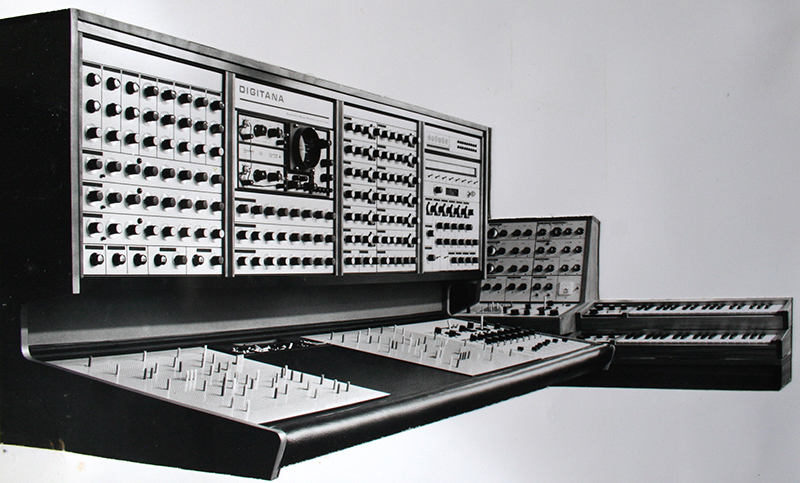
EMS archives, courtesy of Robin Wood.
Construction and development continued into the New Year but by the end of January a more-or-less functioning Delaware was viewed by Desmond Briscoe, and in February a team from Belgrade were in London to inspect, and pick up their ‘Digitana’. During their visit, however, they noted a number of faults and shortcomings, so EMS proposed that rather than deliver this, the first device to be built, they incorporate the fixes and modifications in the third, (the second being the Delaware).
EMS serial-number nerds may be interested to know that this, I think, explains why the Belgrade synth is third in the Synthi 100 numbering sequence, not the first. The Digitana, having been rejected by Belgrade, went first to Zinovieff’s Putney studio, appearing in many publicity photos, and then to Cardiff University. This is No. 3002. The Delaware went to the BBC Radiophonic Workshop and was No. 3003. The synthesiser delivered to Radio Belgrade is No. 3004. So what about No. 3001? Well, I don’t know (and I don’t know anyone who does), but I suspect that no device with this serial number was produced, or if this number was attached to anything it was perhaps some early abortive version of the Belgrade synth.
While all this design and development was going on, EMS were also working on a much humbler, but arguably much more consequential project – to produce a more compact, more portable version of the VCS3. This would result in what would be EMS’s cheapest synthesiser – the Synthi A.
During 1970, the VCS3 (with or without its keyboard) had been adopted by many rock notables including Pete Sinfield of King Crimson, Andy Mackay of Roxy Music, Dave Gilmour of Pink Floyd, Pete Townshend of The Who, and John Paul Jones of Led Zeppelin. But with its unusual shape and relatively fragile construction, the VCS3 was not particularly well suited to the rigours of life on the road. On to the sleeve note of his 2009 album Gracility, composer, bassist and early VCS3 adopter Laurie Scott Baker says:
The idea [for the Synthi A] came out of a discussion between myself and John Paul Jones when we were staying at his place. He had just come back from an extensive tour of the States [August-September 1970] and was explaining how difficult touring was, particularly taking the VCS3 around in hotel rooms packing it up etc. He joked that it would be nice if it just fitted into a suitcase so you could simply fold it up and go. I knew what components were in it and said that technically it was not out of the question. When we visited family in Bournemouth I talked to Gerry Rodgers and his brother Brian who actually manufactured VCS3s, whom I had met before. I told them John was willing to pay for a portable one. Subsequently one of them happened to find a job lot of briefcases in an auction, so next thing they arrived at EMS with a prototype!
The veracity of this account has yet to be confirmed, but it is plausible, and it’s certain that the challenge of fitting the circuitry of the VCS3 into a briefcase (a Spartanite Executive Twin) by early 1971 was undertaken by Brian Rodgers, who also came up with the name for the one-off prototype: The Portabella.
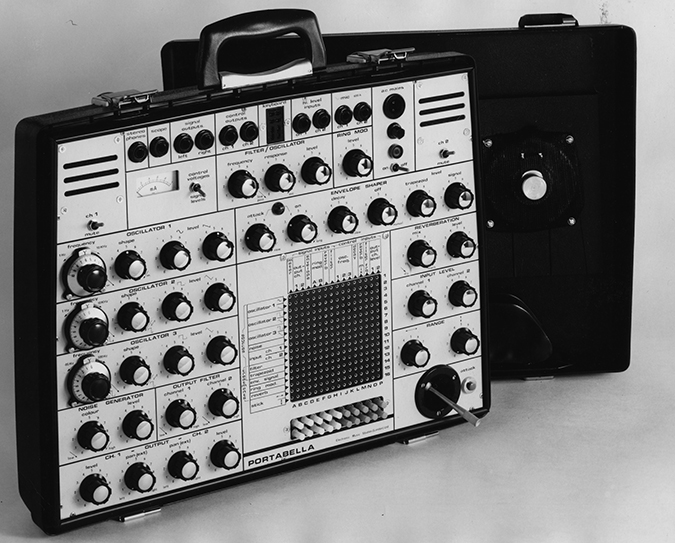
Author’s collection/EMS archives, courtesy of Robin Wood
The current whereabouts of the Portabella are unknown, but one apocryphal account has it that the prototype was sent to Deodar Road at the same time as Stockhausen was visiting. In a moment of “exuberance”, Zinovieff gave the Portabella to Stockhausen, who happily accepted it and went back to Germany before Zinovieff sobered up and realised what he’d done.
There actually seems to be some truth in this tale, though it seems unlikely that it was the Portabella prototype that was gifted. Stockhausen was indeed in London for concerts in late April/early May 1971, not long before the Synthi A’s official launch, and Peter Eötvös – then in Stockhausen’s group – confirmed to me in an interview that Stockhausen was given a Synthi A when visiting Zinovieff’s house during this time. Furthermore, in a letter to Zinovieff, in the archives of the Stockhausen Verlag, and dated May 11 1971, Stockhausen says “how much I was touched by your generous gift. I couldn’t believe it” [my translation] – almost certainly this Synthi A.
However, I digress, and we’re getting into Part Two territory here. When we pick up the story, the names ‘Putney’, ‘The Cricklewood’, ‘Digitana’ and ‘Portabella’ will have been dropped, and the EMS product line unified under the ‘Synthi’ brand. But that’s for next time…
[Part Two of this article will appear in 2022]
Further reading:
On the genesis and development of the VCS3:
https://www.cambridge.org/core/journals/organised-sound/article/don-banks-music-box-to-the-putney-the-genesis-and-development-of-the-vcs3-synthesiser/38928808A05A6F2118B148CE302E3764
2010 interview with Peter Zinovieff
https://www.rnz.co.nz/concert/programmes/hopefulmachines/audio/201812332/interview-peter-zinovieff
2010 interview with David Cockerell
https://www.rnz.co.nz/concert/programmes/hopefulmachines/audio/201812323/interview-david-cockerell
Brian Hodgson memoir
https://whitefiles.org/rwb/1/index.htm
‘Peddling The Putney: The Early Marketing of the VCS3 Synthesizer’
The first ten pages of this chapter can be downloaded here:
https://www.cambridgescholars.com/resources/pdfs/978-1-5275-5002-5-sample.pdf
The chapter appears in this book:
https://www.cambridgescholars.com/product/978-1-5275-5002-5
Essential reading for context: Tape Leaders: A Compendium Of Early British Electronic Music Composers by Ian Helliwell.
https://velocitypress.uk/product/tape-leaders-book/
